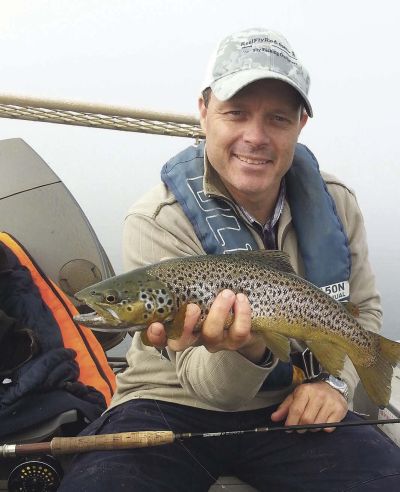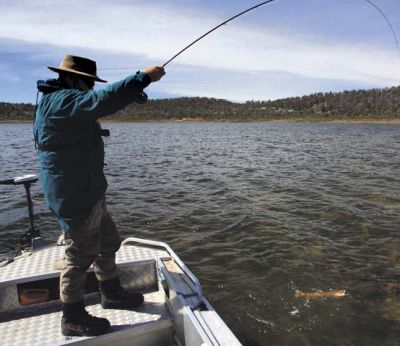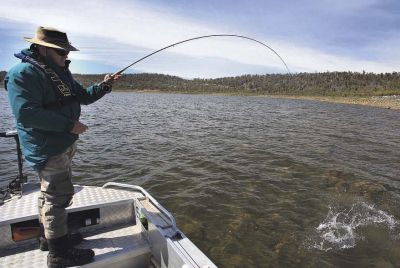 Presented from Issue 114, February 2015
Presented from Issue 114, February 2015
There was a time when I thought Great Lake was a barren and unappealing body of water. My opinion soon changed as I discovered the existence of midge feeding trout out in the middle of this Lake back in the late 80’s after reading Robert Sloane’s classic book “The Truth About Trout”. Since then, there have been many new publications from very competent anglers who have spent a lot of time unlocking its secrets. Great Lake can produce some superb dry fly fishing during the summer months and the best way to experience this, in my opinion, is from a boat. Once you have a boat on the water it opens up so many opportunities to find feeding fish. It also gives you the freedom to cover a lot more water to find fish as the conditions change.
 |
| The clear waters of Great Lake make for exciting fishing -especially when you see a trout engulf your fly or lure. |
Midge Hatch
Midge pupa can be found swimming to the surface to hatch when the wind drops out in the evening and will continue throughout the night and into the early hours of the morning whenever these calm conditions prevail. It’s always an exciting time to be on the water when you find trout feeding on these tiny insects because of the constant surface feeding activity that is so visible from a boat. It makes staying on the water until dark or that early pre dawn start, so worth the effort. Great Lake trout are accustomed to finding all kinds of terrestrials mixed up with the midge on the water. I think this is one of the reasons why these fish take the larger foam flies so readily. That’s not to say they wont refuse these larger foam flies at times but they do stand out from the carpet of midge on the water, giving these fish the opportunity to eat something 100 times larger with one mouth full. Refusals often happen during those glassed out periods when the sun gets up. This behavior usually changes as the wind creates a ripple or small wave across the Lake to add movement to those rubber legs and to further disguise the fly and leader.
Wind lanes
When the wind starts to blow after a midge hatch, wind lanes are often created. These calm strips of water are clearly defined among the waves and will start to collect many of the remaining midge and any terrestrials that are left or freshly deposited onto the water. In the absence of an early morning midge hatch, a gum beetle fall can be a savior during a hottest part of the day. Trout will predominantly feed up into the wind in the calm slick of the wind lane as well as the rough broken water on both sides of the wind lane. When fishing very narrow wind lanes I like to drift the boat in amongst the broken water on one side of the wind lane, just to have a better chance of hiding the boat and to make it harder for the fish to see the movement of the casting angler. While on those very wide wind lanes it is often better to position the boat in the middle of the wind lane to reach those fish swimming up the sides of the lane in the broken water. Sometimes the wind will change direction and start to blow across a wind lane that is full of food and feeding trout. This change of direction, will often destroy the formation of the wind lane and disperse the narrow strip of insects and trout throughout the lake, amongst the foam lines and waves. This is the time to either fish the foam lines or Polaroid the waves for those high riding fish.
Foam Lines
Drifting down the more defined foam lines can be another good way of picking up a few more fish. This is a good option when polaroiding fish in the waves is not a viable option. This changes the concept of looking for whole fish back to looking for signs of fish rising or feeding just beneath the surface. Subtle signs to watch out for is a wake of water being pushed against the prevailing wind ripple or wave or a glimpse of a head or tail as a fish takes something in or outside of the foam. Distinguishing these signs can take some time to train your eyes. I just go ahead and cast to anything that looks out of place. Quite often if I think I have just seen something odd in the water then there is a very big chance it was a fish. It’s costs you nothing to make a quick leading cast, so back your judgment and more often than not, you will be rewarded. It’s also a good idea to make a series of short searching casts amongst the foam while your looking for fish. This is an effective way of raising any fish that may be hidden under the foam or that swimming too deep to see. In this situation, the best sign of a fish, is the one that is about to eat your fly.
Sharking
If the wind is blowing in a northerly direction and the sun is shining through the clouds. This is a really good time to use the electric or the main outboard motor to travel along the waves to look for fish that are still swimming high in the waves looking for food. This form of fly fishing is commonly called “Sharking” because of the way the sun light illuminates their shark like shape against the green depths of the Lake. The best conditions to try this are during those hot northerly winds when there is a chance of a gum beetle fall to add to the mix of that early morning midge hatch. The northerly wind also produce a wave that is travelling south down the lake which provides a perfect window to see fish in the back of each wave with the sun positioned perfectly behind you. When there are a lot of fish concentrated in one area there is no need to cover a lot of water to find fish, so an electric outboard is perfect in this situation. Unfortunately this is not always the case and it is often necessary to use the main outboard motor to cover large expanses of water by zig zaging across and down the lake to find fish. Because these fish are so easy to see they are often spotted a long way from the boat. This allows plenty of time for the driver to pull the motor out of gear and the lucky angler to make the cast to deliver the fly with an intentional “splatt”. This heavy landing signals the arrival of something worth eating and a fish will often change direction from some distance to find the fly. I am constantly amazed at how these fish can sense a fly landing amongst waves that are two foot high and white capping. In these conditions they rarely refuse at the chance to eat one of these large counterfeit foam insects, be it a beetle or ant, they really don’t care.
Boat Polaroiding the Shoreline
Ultimately there has to be some form of food out in the middle of the lake to encourage trout to feed at the surface, find the food and trout won’t be too far away. So when food and fish are hard to find out in the lake, polaroiding the shoreline from a boat can be another good option to find a few more fish. I like to seek out those shorelines that have a silty or weedy bottom with the wind blowing into them. The wind and wave action distributes a lot of surface and subsurface food hard up against the shoreline and can attract a lot of fish. This wave action can also create a dirty band of water, hard in along the shore line. Trout move through this dirty water seeking out the accumulation of stick caddis and other food items that may have been dislodged by the waves or blown in on the wind. I like to sneak along these shores with the electric outboard or simply let the boat drift back into the shore with the wind.
 |
| Fishing a dry fly along shallow rocky shores can be very productive. |
A Day On Great Lake
The weather forecast looked promising, with a warm northerly wind predicted for the Central Highland. I made a quick call to my good friend Jim Schofield, who I know just loves to fly fish this lake from a boat. Jim’s immediate reply was, “when do you want me to pick you up” 3:30 am sound good to me, I said. An early start like this was standard procedure when traveling from Devonport. So right on time I was picked up the next morning with a clear star lit sky over head and not a breath of wind. Things looked good until we drove down onto the Northern end of the lake and were confronted with a lake covered in thick fog. Jim and I both knew that finding feeding fish in thick fog is always difficult so we decided to keep driving south in the hope of finding a bay that didn’t have as much fog. Brandum Bay did look promising as we drove past, with a small area of calm water directly out from the boat ramp that was not covered in fog. Jim wanted to drive down to check Swan Bay out, which has produced many memorable mornings for him over the years so we kept this in mind and continued south. When we arrived at Swan Bay boat ramp, it wasn’t good, the fog was thick and the wind was already blowing straight into the boat ramp. We both agreed that Brandum’s Bay was going to be our best option to find fish.
When we returned, we were immediately greeted by fish rising to midge only thirty metres from the boat ramp. We hastily launched the boat and used the electric outboard to position Jim within casting distance to the first fish. Jim had already tied on one of his own, already chewed, size 10 foam Chernobyl Ant creations. I think he must have run out of Peter Broomhall’s superbly tied and much prettier “Brusers Bugs”. Jim laid out a cast to lead the fish, the fly landed with a splat which always seems to redirect their attention towards the fly. The fish boiled under the fly, signaling a disappointing refusal. Not to worry, there were many more tails and rises coming out of the fog as more fish mopped these tiny midge. The next fish Jim cast to refused the foam again but he was not discouraged by these refusals because he knows from experience that eventually, he will cover a fish that wants to eat foam. On the third fish the fly was taken without hesitation. Jim soon had a nice Great Lake Brown Trout of around two pound thrashing around in the landing net. We switched places, Jim on the electric and me on the bow ready for the next fish. We both caught a couple more fish before the fog surrounded us and they became even more selective. With our sight limited by the fog we sat quietly and listened for the sound of a trout rising around us. We moved the boat towards the sound of the rise, until the fish came within view. This worked quite well to locate fish but both Jim and I were having trouble judging the length of the cast in the fog which had changed our perception of distance, making these rising fish look much further away than they where.
The fog also puts a lot of strain on your eyes as you look harder than ever to see fish in the white misty fog that is now being lit up by the sun. We managed a few more fish from the fog until it finally lifted. The water remained calm and the true extent of the hatch was revealed with large rafts of midge on the water and packs of fish gorging themselves. What looked like it was going to be easy was anything but, as we had refusal after refusal. Then all of a sudden we would find a dumb one and it would eat. The wind got up as expected and formed a good wind lane from the start of Little Lake Bay to almost the start of Brandum’s Bay. Despite its impressive size and the odd gum beetle being blown past, there just wasn’t the food in this wind lane to keep many fish interested. Jim and I both caught a couple more using the same foam Chernobyl type flies in this wind lane before we moved onto polaroiding fish in the back of the waves. Again because of the lack of food in the water we only managed to find a couple of fish while zig zaging down the lake for more than 800 m. Both fish ate the fly without hesitation, while the outboard continued to idled away in neutral. From here we did a quick run over the bay to see if we could find a concentration of food or fish but the Gum Beetles had stopped flying so there were no fish to be found. We then moved into a silty bay at the northern end of Renolds Neck where the wind and waves were pounding the shore line. As soon as we drifted over the shallow silty bottom of this Bay we found fish. We did several drifts into this shore from a couple of hundred metres out in the lake.
We began by fishing the foam lines until it became shallow enough to see fish on the bottom, once again. This produced quite a few fish late in the afternoon. The cold front was pushing in so we decided to pull the boat out of Brandum bay and tow the boat around to Canal Bay where we could fish the foam lines over the shallow weedy bay. Two more fish were put on the tally after 4 drifts across this bay. Then just before dark with the cold wind blowing we took the boat out in the middle of the main lake to drift down a thick foam line in amongst waves that must have been half a metre high. In the fading light I just happened to be looking in the right direction to see a tail slid through a wave. I picked up my fly and and dropped it a two metres in front of where I had last seen the tail. I waited and waited and was just about to pick the fly up off the water to recast, when a snout come over the fly and ate it. A few minutes later the same thing happened and another fish was brought to the boat to be released. A total of 19 fish between us for the day, in less than perfect conditions. Not a bad way to spend a day on the water!.
Craig Rist
